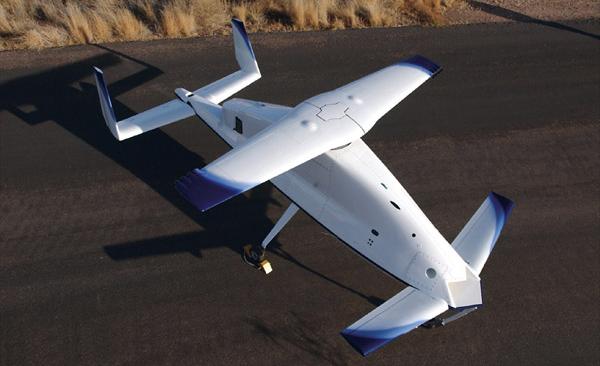Boeing X-50 Dragonfly
In the 1990s, McDonnell Douglas studied a VTOL aircraft design concept called CRW (Canard Rotor/Wing). A CRW aircraft would use a wide-chord two-blade rotor for vertical take-off and landing, while the rotor could be stopped and act as a fixed wing for high-speed forward flight. Part of the funding for these studies came from the U.S. Navy and Marine Corps, which have possible requirements for fast VTOL aircraft and UAVs. In 1998, DARPA (Defense Advanced Research Projects Agency) eventually awarded a contract to Boeing (which had acquired McDonnell Douglas) to build an unmanned CRW demonstrator, named Dragonfly by Boeing. In 2002, the official designation X-50A was allocated to the vehicle. At that time, the next number in the X-series was X-49, but design number 50 was assigned out-of-sequence at the request of Boeing and DARPA, because it fits the CRW concept: a 50/50 mix of helicopter and fixed-wing aircraft.
 |
| Photo: Boeing |
| X-50A |
The X-50A was powered by a single F112 turbofan engine, and the control surfaces of the vehicle consisted of fully-movable canards and a tailplane with twin endplates. The UAV was equipped with a fixed tricycle landing gear. For operation as a helicopter, the engine's exhaust was diverted to small nozzles in the rotor tips. Because of the reaction-driven rotor, no anti-torque device was needed by the CRW. As forward speed increased and significant lift was generated by the tail and canards, the engine thrust was gradually redirected to the tailpipe, until sufficient speed had been reached to stop the rotor completely and fly as a conventional fixed-wing jet. The X-50A was flown by a pilot on the ground via remote control, and there was no system installed for fully autonomous operations.
 |
| Photo: Boeing |
| X-50A |
The first hover flight of the X-50A occurred on 4 December 2003, more than a year after the originally planned time frame. However, the career of the vehicle was short, because it was destroyed in a crash on 23 March 2004. After a thorough investigation, cross coupling of the rotor controls was identified as the major reason for the crash. After several modifications to the second X-50A, which had been built as a back-up vehicle, the CRW program was continued with extensive ground tests.
Flight testing of the second vehicle finally began on 4 November 2005, and continued with two more tests in December. These tests successfully verified the hardware and flight control software modifications made after the crash of the first X-50A. A series of 11 test flights was planned for the first quarter of 2006, and was to culminate in the first full transition to pure fixed-wing mode and back. However, the vehicle was destroyed in a crash on 12 April, and in September 2006, DARPA decided to terminate the program.
Specifications
Data for X-50A:
| Length | 5.39 m (17.7 ft) |
| Wingspan / Rotor Diameter | 3.66 m (12 ft) |
| Height | 2.0 m (6.5 ft) |
| Weight | ? |
| Speed | ? |
| Propulsion | Williams F112 turbofan |
Main Sources
[1] Boeing Website
[2] GlobalSecurity.org Website
Back to Directory of U.S. Military Rockets and Missiles, Appendix 4
Last Updated: 14 September 2006